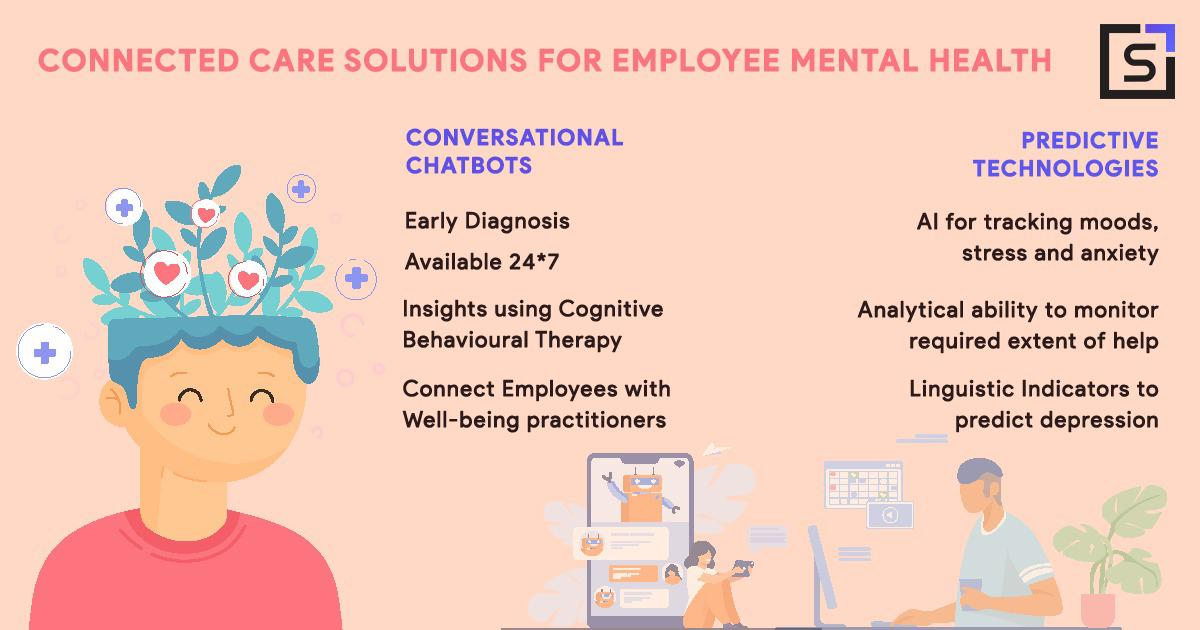Read news, articles, knowledge posts and opinions
on technology in healthcare
One in five workers encountered mental health issues before the COVID-19 pandemic, but today, nearly 50 percent of employees say their mental health has declined due to COVID-19.

One in five workers encountered mental health issues before the COVID-19 pandemic, but today, nearly 50 percent of employees say their mental health has declined due to COVID-19.
Financial stresses due to the global economic situation are also affecting the mental health of employees.
Employees now are facing a slew of mental and physical health problems, including stress, anxiety, depression, alcoholism, hypertension, and many other adverse outcomes than feeling energized and happy. In the present work from home setting, there is no difference between personal and professional lives; people now find it difficult to juggle household work and career. There is increased level of stress in employees about COVID-19 and how to protect themselves and their loved ones. Financial stresses due to the global economic situation are also affecting the mental health of employees.
On 10 October each year, World Mental Health Day is celebrated, with the overall goal of raising awareness of mental health problems worldwide and mobilizing efforts to improve mental health.
Technology can impress us in many ways, and one can find sufficient proof of this if we study the success of the last ten years. Changing the way we view jobs and how we take care of ourselves, data, and Artificial Intelligence (AI) has been instrumental. The advancement is now trying to improve the way we deal with mental stress and wellbeing as well.
Chatbots are useful tools for people with mental disorders, particularly those who are reluctant to seek mental health advice because of stigmatization.
? They are designed to be conversational, receptive to keywords to detect the individual's mood, accessible 24/7, and support by offering insights using cognitive behavioral therapy (CBT).
? Chatbots can identify employees that need intervention early and refer them to mental
? Give patients well-detached analyzed data to self-regulate their psychological condition.
? Send users advice about their psychological well being.
To better recognize and predict psychiatric diseases in employees, NLP and Machine Learning are opening up new possibilities for how mental health practitioners can assess free speech.
? Automated speech analysis can have a predictive capacity that exceeds today's traditional clinical assessment methodologies and scoring systems as NLP and machine learning technologies become more sophisticated.
? Free text (e.g., EHR notes, patient portal messages) are also assessed by NLP and machine learning algorithms to help predict employees who may be at risk of self-harm or psychological distress, allowing care teams or other caregivers to intervene more rapidly.
? Artificial intelligence systems can track the pronunciation of words and tone of voice for stress by an employee, identify linguistic indicators that could predict depression, evaluate heart rate increases, increase typing speed, or slow down productive performance, all of which could be warning signs for an employer, to aid in real-time monitoring of mental health problems, smartwatches or biometric data, like facial expression.
Many patients who need mental health services do not receive it or choose not to seek help for the fear of social stigma.
For patients in need, tele-health makes mental health treatment more available and convenient.
? Telehealth improves access to specialized mental health services that might not otherwise be available (for example, in rural areas)
? Brings care to the place of the patient
? Support to combine primary care and mental health care, leading to improved results
? Reduces the need for emergency room visits
? Reduces treatment delays
? Improves treatment and follow-up continuity
? Reduces the need for time off work, child care centers, etc. to reach far-away appointments
? Reduces possible obstacles to transport, such as lack of transport or the need for long drives
? Reduces the barrier of stigma around mental health
Employers need to provide their staff with the right training and education around mental health issues by addressing key employee wellbeing challenges in the early stages, reducing the stigma attached to it, providing team members with connected care, improving productivity, and save costs.
4th Floor, 3rd Eye Vision Complex,
IIM Road Ahmedabad - 380015, Gujarat.

 Download Resources
Download Resources